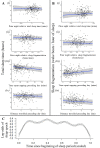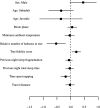Ecological and social pressures interfere with homeostatic sleep regulation in the wild
- PMID: 35229719
- PMCID: PMC8887896
- DOI: 10.7554/eLife.73695
Ecological and social pressures interfere with homeostatic sleep regulation in the wild
Abstract
Sleep is fundamental to the health and fitness of all animals. The physiological importance of sleep is underscored by the central role of homeostasis in determining sleep investment - following periods of sleep deprivation, individuals experience longer and more intense sleep bouts. Yet, most sleep research has been conducted in highly controlled settings, removed from evolutionarily relevant contexts that may hinder the maintenance of sleep homeostasis. Using triaxial accelerometry and GPS to track the sleep patterns of a group of wild baboons (Papio anubis), we found that ecological and social pressures indeed interfere with homeostatic sleep regulation. Baboons sacrificed time spent sleeping when in less familiar locations and when sleeping in proximity to more group-mates, regardless of how long they had slept the prior night or how much they had physically exerted themselves the preceding day. Further, they did not appear to compensate for lost sleep via more intense sleep bouts. We found that the collective dynamics characteristic of social animal groups persist into the sleep period, as baboons exhibited synchronized patterns of waking throughout the night, particularly with nearby group-mates. Thus, for animals whose fitness depends critically on avoiding predation and developing social relationships, maintaining sleep homeostasis may be only secondary to remaining vigilant when sleeping in risky habitats and interacting with group-mates during the night. Our results highlight the importance of studying sleep in ecologically relevant contexts, where the adaptive function of sleep patterns directly reflects the complex trade-offs that have guided its evolution.
Keywords: biotelemetry; ecology; evolutionary biology; homeostasis; olive baboon; predation risk; sleep; social behavior.
© 2022, Loftus et al.
Conflict of interest statement
JL, RH, CN, MC No competing interests declared
Figures















Comment in
-
Accelerometer-based analyses of animal sleep patterns.Elife. 2022 Mar 8;11:e77349. doi: 10.7554/eLife.77349. Elife. 2022. PMID: 35258454 Free PMC article.
Similar articles
-
Sharing sleeping sites disrupts sleep but catalyses social tolerance and coordination between groups.Proc Biol Sci. 2024 Nov;291(2034):20241330. doi: 10.1098/rspb.2024.1330. Epub 2024 Nov 6. Proc Biol Sci. 2024. PMID: 39501885 Free PMC article.
-
The role of sleeping sites in the predator-prey dynamics of leopards and olive baboons.Am J Primatol. 2018 Dec;80(12):e22932. doi: 10.1002/ajp.22932. Am J Primatol. 2018. PMID: 30537388
-
Accelerometer-based analyses of animal sleep patterns.Elife. 2022 Mar 8;11:e77349. doi: 10.7554/eLife.77349. Elife. 2022. PMID: 35258454 Free PMC article.
-
Darwin's monkey: why baboons can't become human.Am J Phys Anthropol. 2012;149 Suppl 55:3-23. doi: 10.1002/ajpa.22158. Epub 2012 Oct 17. Am J Phys Anthropol. 2012. PMID: 23077093 Review.
-
Beyond the here and now: hunter-gatherer socio-spatial complexity and the evolution of language.Philos Trans R Soc Lond B Biol Sci. 2024 Oct 21;379(1912):20220521. doi: 10.1098/rstb.2022.0521. Epub 2024 Sep 4. Philos Trans R Soc Lond B Biol Sci. 2024. PMID: 39230448 Free PMC article. Review.
Cited by
-
The effect of group size on sleep in a neotropical bat, Artibeus jamaicensis.J Exp Zool A Ecol Integr Physiol. 2024 Dec;341(10):1097-1110. doi: 10.1002/jez.2860. Epub 2024 Jul 25. J Exp Zool A Ecol Integr Physiol. 2024. PMID: 39051138 Free PMC article.
-
Baboon travel progressions as a "social spandrel" in collective animal behaviour.Behav Ecol. 2025 Mar 11;36(4):araf022. doi: 10.1093/beheco/araf022. eCollection 2025 Jul-Aug. Behav Ecol. 2025. PMID: 40568525 Free PMC article.
-
Sleep tight! Adolescent sleep quality across three distinct sleep ecologies.Evol Med Public Health. 2023 Nov 21;11(1):448-460. doi: 10.1093/emph/eoad040. eCollection 2023. Evol Med Public Health. 2023. PMID: 38044930 Free PMC article.
-
Sharing sleeping sites disrupts sleep but catalyses social tolerance and coordination between groups.Proc Biol Sci. 2024 Nov;291(2034):20241330. doi: 10.1098/rspb.2024.1330. Epub 2024 Nov 6. Proc Biol Sci. 2024. PMID: 39501885 Free PMC article.
-
Bridging the gap between lab and field sleep studies: a proof-of-concept for studying wild rats in semi-captive environments.Sleep Adv. 2025 Jul 10;6(2):zpaf036. doi: 10.1093/sleepadvances/zpaf036. eCollection 2025 Apr. Sleep Adv. 2025. PMID: 40641677 Free PMC article.
References
-
- Altmann SA, Altmann J. Baboon Ecology: African Field Research. University of Chicago Press; 1970. - DOI
-
- Amlaner CJ, Phil D, Fuller PM. Basics of Sleep Guide. Sleep Research Society; 2009.
-
- Bäckman J, Andersson A, Pedersen L, Sjöberg S, Tøttrup AP, Alerstam T. Actogram analysis of free-flying migratory birds: new perspectives based on acceleration logging. Journal of Comparative Physiology. A, Neuroethology, Sensory, Neural, and Behavioral Physiology. 2017;203:543–564. doi: 10.1007/s00359-017-1165-9. - DOI - PMC - PubMed
Publication types
MeSH terms
Associated data
LinkOut - more resources
Full Text Sources
Other Literature Sources

